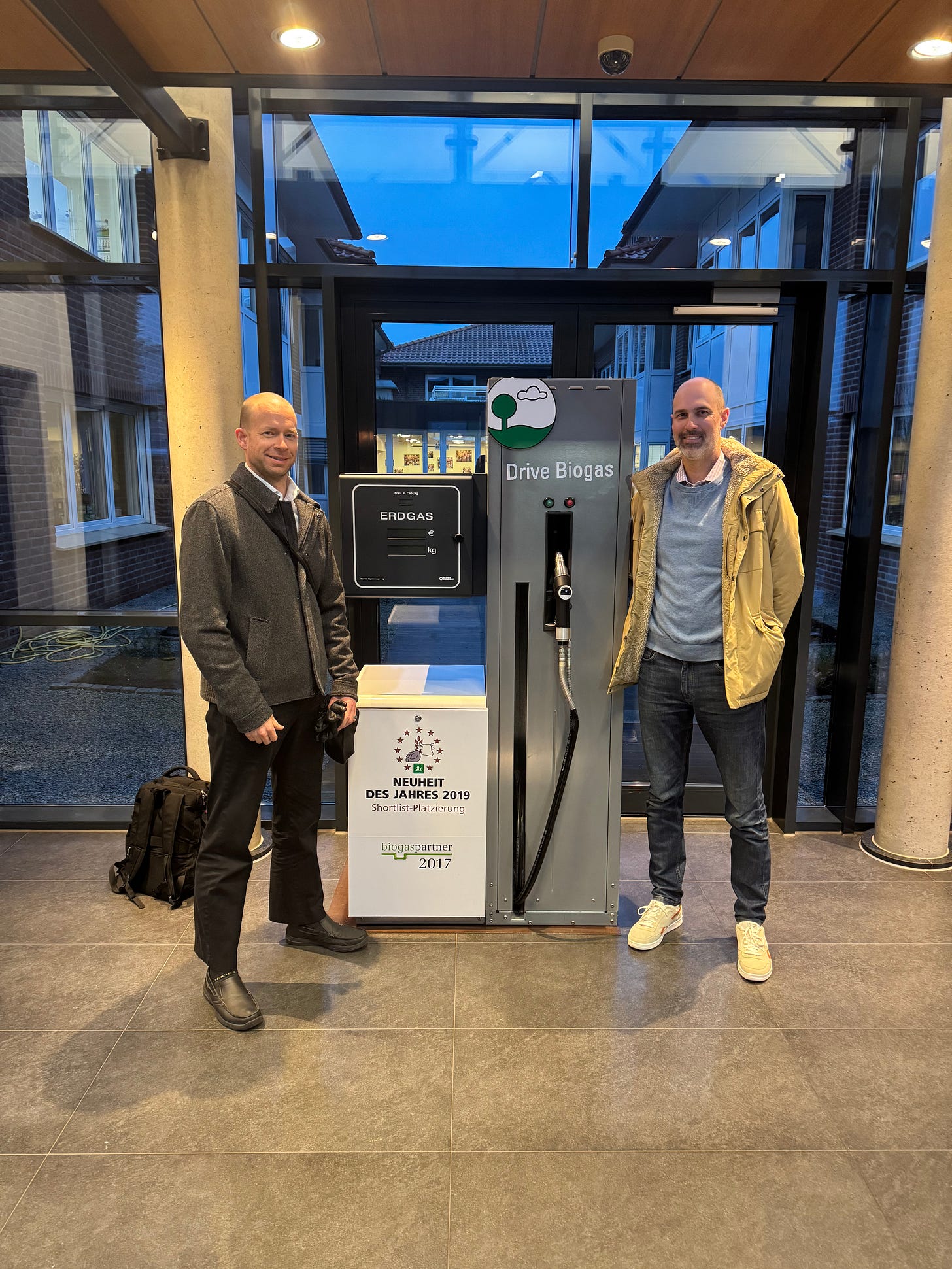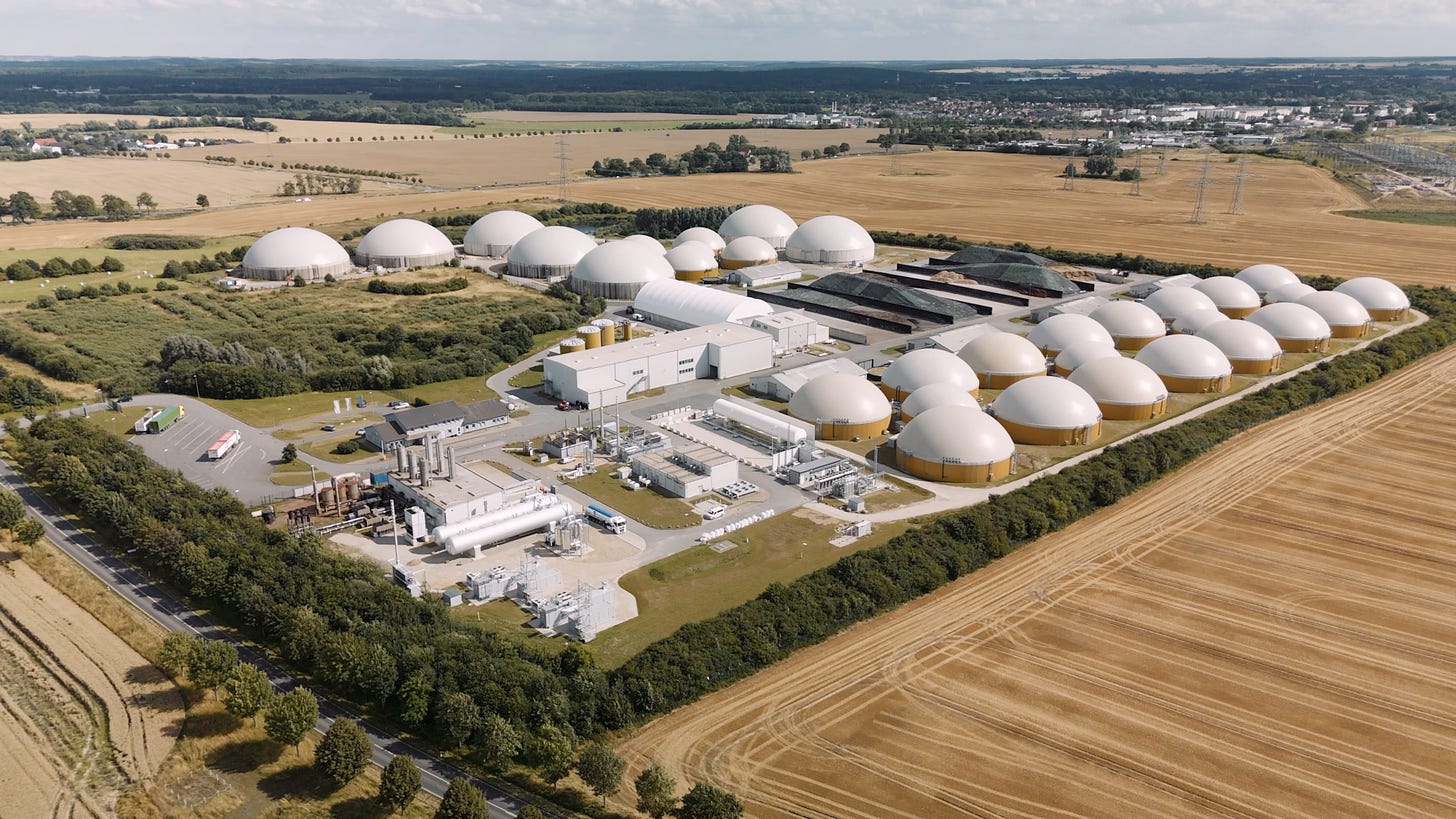Lessons Learned from the German Biogas Market: A Potential Model for US Replication?
Background
For nearly 15 years, Energy Vision has focused on the intersection of waste and renewable energy, particularly the technologies, policies, and markets that transform urban and agricultural organic waste into energy and nutrient resources. We've long studied the European biogas market, but it wasn’t until our recent trip to Germany that we finally saw it firsthand. The experience confirmed many of our assumptions and left us optimistic about the potential for biogas expansion in the U.S., despite key differences between the two countries.
In early February, we joined a German biogas study tour hosted by EnviTec Biogas, alongside representatives from the U.S. and Brazil. The goal was to gain firsthand insight into the past, present, and future of Germany’s biogas sector.

The German Biogas Landscape
Germany, a country with roughly 20% of the U.S. population and half the size of Texas, leads the world in anaerobic digestion (AD) adoption. It operates nearly 9,000 AD systems—roughly 4x the number in the U.S.—with many being small-scale agricultural facilities producing under 1 megawatt of electricity.
You can read a lot more about the history of the German biogas market here, but there are a few key themes associated with the buildout of this sector in Germany over the past 25 years:
Supportive policies providing certainty to developers/investors
Public awareness/acceptance
Geopolitics favorable to bioenergy
The German biogas sector really began to take shape with the introduction of the Renewable Energy Sources Act in 2000 (Erneuerbare-Energien-Gesetz or EEG) and subsequent amendments/expansions of this policy. At the heart of this policy measure was the inclusion of a biogas “feed in tariff”; i.e. a guaranteed premium 20-year price to be paid for biogas-derived energy. Ultimately, providing long-term certainty and price stability for the sale of energy derived from biogas was the most important element, as it gave biogas producers, developers and investors the clarity they needed to build out this infrastructure.
Much more recently, the war in Ukraine and direct impacts on Germany’s energy security – namely the shutoff of Russian gas in September 2022, which had accounted for 55% of Germany’s natural gas demand – significantly bolstered the need for domestic and non-Russian supplies of gas, which has markedly expanded opportunities for the local production of “biomethane” (also known as renewable natural gas, or RNG) all across Europe.
For reference and comparisons to the U.S. landscape, as highlighted in our previous post, the 9,000 digesters in Germany are nearly twice the number of new AD systems Energy Vision calculated would be necessary in the U.S. to transform our abundant streams of municipal, suburban, industrial, and agricultural “waste” into renewable energy and nutrients. (The buildout and ongoing operation of 4,700 additional U.S. AD systems would also cut net methane nearly 14%, which is comparable to the methane emission reductions envisioned by sweeping measures to address the oil and gas industry. Together, Energy Vision calculated that they could allow the U.S. to reach its “30x30” goal of cutting methane emissions 30% by 2030, which is critical for avoiding runaway climate change.)
Growing Pains
Germany has achieved remarkable progress in the development of its biogas sector, and its broader transition to renewable energy (Energiewende), but overcoming the significant challenges along the way hasn’t been easy or cheap. The shift away from fossil fuels and nuclear power has required major investment, complex political negotiations, and occasional setbacks, much of which is still playing out today.
Furthermore, comparing Germany’s biogas success with the U.S. highlights fundamental differences in philosophy, economics, and geography. While Germany’s centralized policies have propelled the industry forward, the decentralized nature of the U.S. energy market and substantial domestic oil and gas resources pose unique challenges. However, the core lessons from Germany remain relevant and offer valuable insights for U.S. adoption.
A Look at the Future – Visiting Guestrow
Our trip provided an in-depth look at multiple biogas projects and the lessons learned by industry pioneers. Among them, EnviTec’s Guestrow facility stood out as a model for what’s technologically possible.
This state-of-the-art plant (see photo below) processes over 100,000 tons of poultry litter (aka “chicken dung”) and agricultural residue annually through anaerobic digestion. The biogas is then upgraded to biomethane by removing carbon dioxide (CO2), moisture, and other impurities. Unlike conventional U.S. facilities, which typically vent CO2, Guestrow captures and liquefies it for sale to beverage manufacturers, adding another revenue stream.

The facility’s impact extends beyond energy production:
● Renewable Fuel for Transportation: The biomethane is further processed into liquefied natural gas (LNG), powering hundreds of heavy-duty trucks that would otherwise run on diesel.
● Energy Self-Sufficiency: With Germany’s high energy prices, a significant portion of the biogas is used on-site via combined heat and power (CHP), making the plant largely independent from the grid.
● Circular Economy Approach: Plans are underway to enhance the recovery of nutrients from the remaining organic material, maximizing the value of waste-derived resources.
Final Thoughts: Lessons for the U.S.
The Guestrow plant exemplifies how biogas technology can be leveraged to reduce emissions, generate renewable energy, and create valuable byproducts. The technology exists, is scalable, and the feedstock is abundant—especially in the U.S. What’s missing is the policy and market framework to fully unlock this potential.
Germany’s experience underscores the importance of long-term policy certainty, public acceptance, and strategic investment. If the U.S. can embrace these principles, biogas could play a critical role in reducing methane emissions, enhancing energy security, and transforming waste into wealth.
What’s needed isn’t more debate, but action. With the right policies, investments, and public awareness, the U.S. can scale up biogas production, cut methane emissions, reduce reliance on fossil fuels, and take a major step toward a sustainable, climate-smart energy future. The resources (“wastes”) are there. The technology is ready. The question is: Will we use it?




